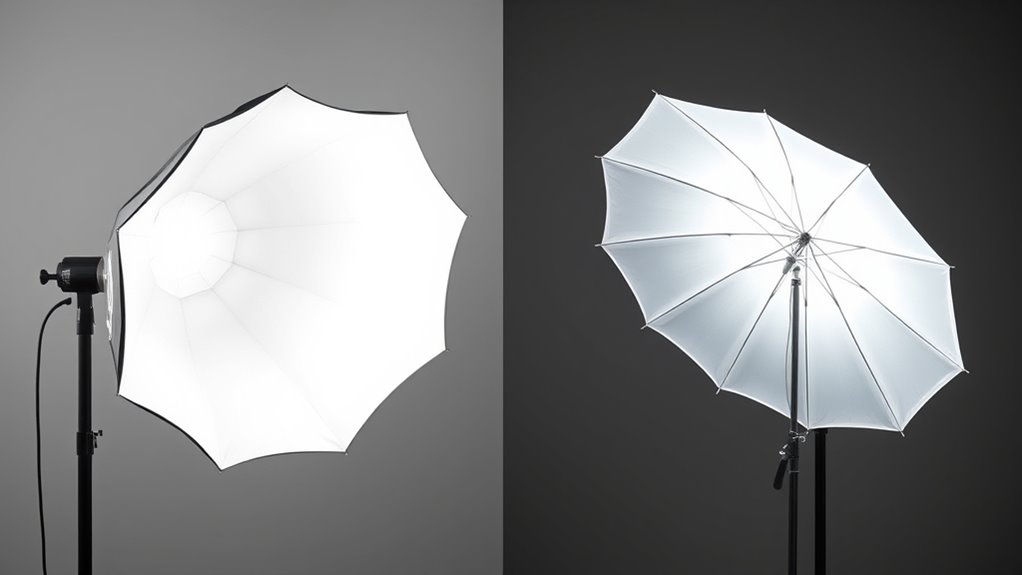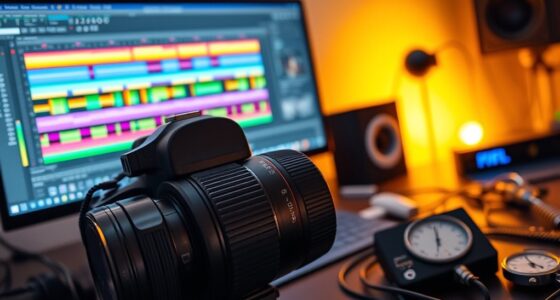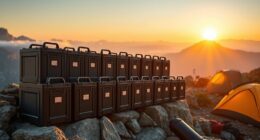When choosing between a softbox and an umbrella, you might assume they’re interchangeable, but each offers distinct advantages. Softboxes give you controlled, even lighting ideal for portraits and product shots, though they’re bulkier to set up. Umbrellas are quick, portable, and great for broad coverage, perfect for on-location shoots. If you want to master your lighting options and understand when to use each tool, continue to explore these differences in detail.
Key Takeaways
- Softboxes provide precise, even, and controlled lighting ideal for professional portraits and product photography, unlike umbrellas’ broader, less controlled coverage.
- Umbrellas are lightweight, portable, and quick to set up, making them perfect for fast outdoor or on-location shoots.
- Softboxes tend to be bulkier and require more space, while umbrellas are collapsible and easier to transport.
- Softboxes reduce light spill and create softer shadows, offering better color accuracy and professional results; umbrellas produce broader light with more spill.
- The choice depends on balancing control and quality (softbox) versus convenience and speed (umbrella).
Key Differences in Design and Functionality
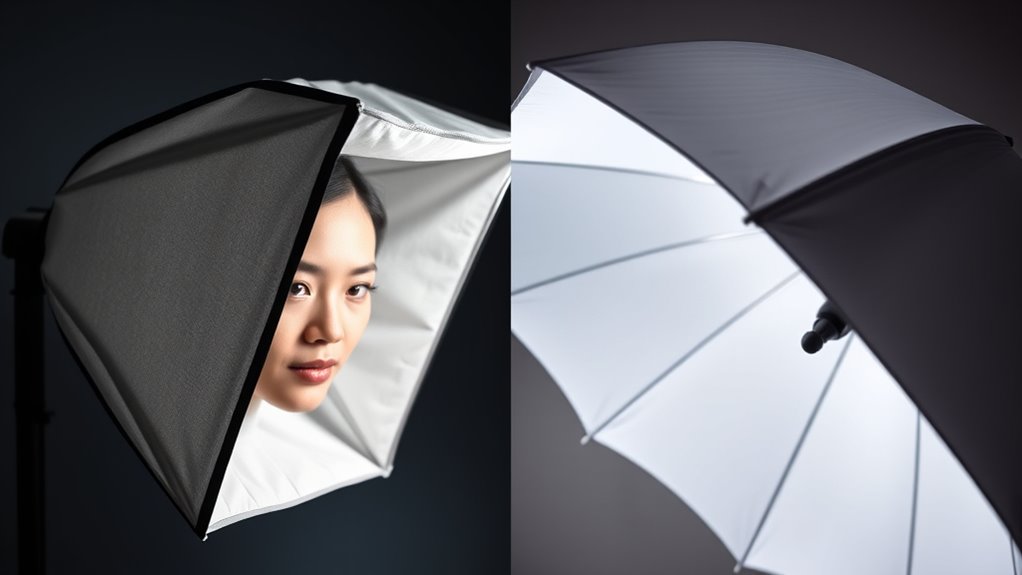
While both softboxes and umbrellas are popular lighting tools, their designs and functionalities differ markedly. Softboxes feature a box-like structure with a front diffusion panel that evenly spreads light, providing controlled light diffusion for softer, more consistent illumination. This design helps reduce harsh shadows and creates a professional look. Umbrellas, on the other hand, are lightweight and collapsible, reflecting or diffusing light through a curved surface. They’re typically more portable, making setup quick and easy, but offer less control over light spill. Softboxes tend to be bulkier, requiring more space for transport, while umbrellas excel in portability considerations. Your choice depends on whether you prioritize precise light diffusion and control or need a compact, mobile solution for quick setups.
Optimal Scenarios for Using Softboxes and Umbrellas
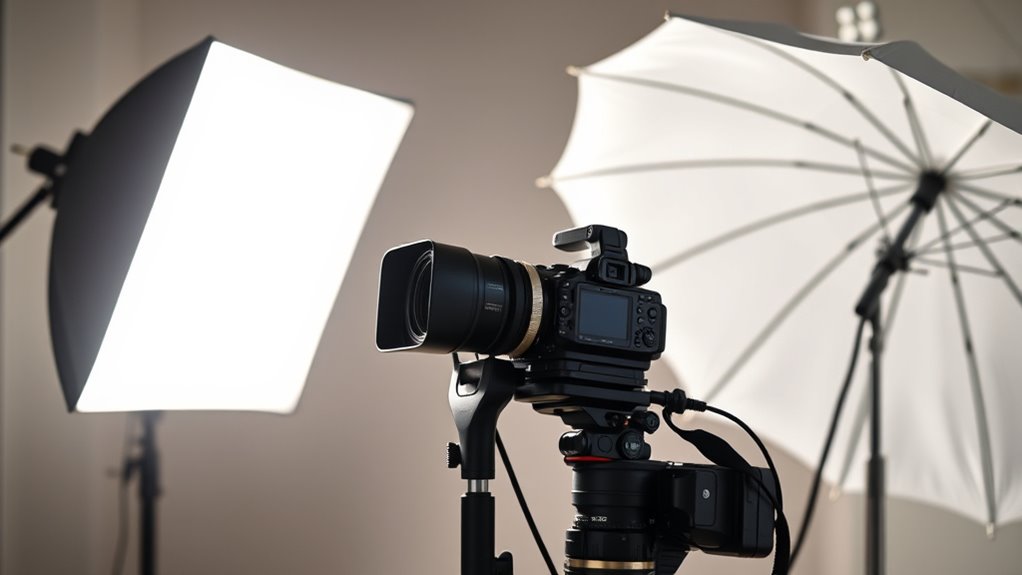
Softboxes excel in scenarios where you need precise, soft, and even lighting, such as portrait photography, product shoots, or studio setups. They minimize light spill, directing light exactly where you want it, which is ideal for controlled environments. Their portability makes them easy to set up and move around, especially in studio settings or outdoor shoots. Use softboxes when you want consistent, flattering light that reduces harsh shadows. Umbrellas, on the other hand, are better suited for quick, versatile setups, especially when you need broader coverage. They’re more portable and easier to transport, making them perfect for on-location shoots or situations where rapid adjustments are necessary. Choose softboxes for precision and control; opt for umbrellas when convenience and speed matter most. Additionally, understanding the color accuracy of your lighting equipment can significantly impact the overall quality of your images, ensuring true-to-life colors in various shooting conditions.
Frequently Asked Questions
How Do Softboxes and Umbrellas Affect Light Color Temperature?
Softboxes generally maintain light color consistency better than umbrellas because they diffuse light evenly, reducing color shifts. Umbrellas can cause slight color temperature adjustments due to their reflective surfaces and material, which may introduce warm or cool tones. When using either, you might need to modify your camera’s white balance for accurate color temperature. This ensures your lighting remains consistent, helping you achieve the desired color temperature adjustment in your photos or videos.
Can Softboxes or Umbrellas Be Used With Outdoor Lighting Setups?
Yes, you can definitely use softboxes or umbrellas with outdoor lighting setups. They’re portable lighting options, making them great for on-location shoots. Just make certain they’re weather-resistant or have some protection from rain and wind, especially if you’re working in unpredictable weather. Using these modifiers outdoors helps control your light, providing softer, more even illumination, which elevates your photography or videography even in challenging outdoor conditions.
What Maintenance Tips Extend the Lifespan of Softboxes and Umbrellas?
To extend your softboxes and umbrellas’ lifespan, stick to regular cleaning routines by gently wiping off dust and dirt with a soft cloth, and avoid harsh chemicals. Proper storage solutions, like keeping them in a dry, cool place and using protective covers, prevent damage from moisture or sunlight. Always handle with care, and check for tears or bent frames before each use to guarantee longevity.
Are There Any Compatibility Issues With Different Camera Brands or Models?
You might face compatibility issues with different camera brands or models due to adapter compatibility and brand-specific issues. Always check if your softbox or umbrella setup includes the right adapters for your camera’s hot shoe or mounting system. Some brands design their accessories to work seamlessly, but others may require extra adapters or modifications. To avoid hassle, research compatibility before purchasing or using your gear across different camera systems.
How Do Softboxes and Umbrellas Perform in High Humidity or Adverse Weather?
In high humidity or adverse weather, softboxes tend to handle humidity effects better because their fabric is usually more sealed and less prone to moisture absorption. Umbrellas, on the other hand, are less weather resistant, often allowing moisture to seep through or damage the material. For better weather resistance, consider using waterproof covers or choosing equipment specifically designed for outdoor conditions, ensuring your lighting stays reliable regardless of weather challenges.
Conclusion
Now that you know the ins and outs of softboxes and umbrellas, you can make smarter lighting choices. Remember, no tool is a one-size-fits-all solution—it’s all about matching your setup to your needs. Don’t be afraid to experiment and find what works best for you; after all, practice makes perfect. With this knowledge, you’ll be ready to shine, no matter which lighting setup you choose. Happy shooting!

